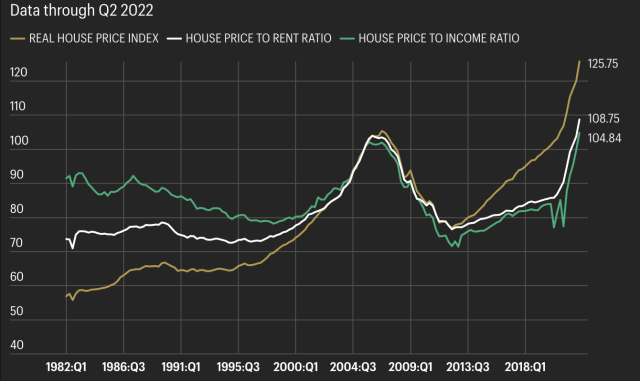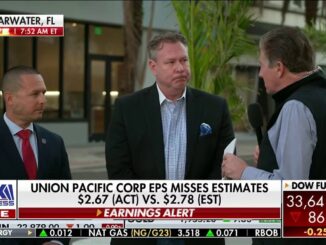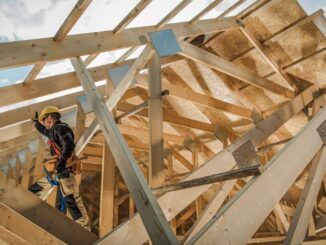
Economists at the Federal Reserve Bank of Dallas caught the attention of the real estate industry back in March 2022 when they published a paper titled “Real-Time Market Monitoring Finds Signs of Brewing U.S. Housing Bubble.”
Soon afterwards, Fortune spoke with Dallas Fed economist Enrique Martínez-García. While the Pandemic Housing Boom isn’t the same story as the lead-up to the 2000s housing crash, he said, home prices were quickly becoming detached from underlying fundamentals.
“This might be a housing bubble. The evidence suggests it looks like a housing bubble. A little bit like a duck. It walks like a duck, it looks like a duck, it certainly might be a duck,” Martínez-García told Fortune in May. “[It’s time to] raise awareness to the potential risks [that] housing poses.”
Fast-forward to February 2023, and economists at the Dallas Fed are once again warning about the downside risks in the U.S. and European housing markets, which have already slipped into a slump following the start of central banks’ rate hiking cycles in 2022.
“While house-price growth has recently begun to moderate—or, in some countries, to decline—the risk of a deep global housing slide persists,” wrote Dallas Fed economists on Tuesday. “Affordability crises arise often from unsustainable and widespread exuberant behavior, data suggest. Particularly concerning, housing has become more prone to excesses spreading across borders, resulting in major misallocation of resources and efficiency losses.”
According to the analysis by Dallas Fed economists, the U.S. house price-to-income ratio in 2022 surpassed its peak level hit at the height of the 2000s housing bubble. Unlike in 2008, this time around we don’t have a subprime crisis or a housing supply glut. However, Dallas Fed economists say U.S. home prices can still fall.
“Achieving a soft economic landing—taming inflation and avoiding a recession, as the Fed accomplished in 1994—cannot be taken for granted given that further monetary policy tightening can increase the household mortgage debt servicing burden and boost the odds of a severe house price correction,” wrote Dallas Fed economists.
In order to “bring the U.S. in line with its [housing] fundamentals,” Dallas Fed economists say U.S. home prices would need to fall 19.5%. While Dallas Fed economists allude to the possibility of such a deep decline, it doesn’t look like it’s their baseline outlook.
“While a modest housing correction remains the baseline scenario, the risk that a tighter-than-expected monetary policy may trigger a more-severe price correction in Germany and the U.S. cannot be ignored,” Dallas Fed economists wrote in their latest article.
According to their research, countries across much of the developed world saw home prices become detached from underlying fundamentals during the Pandemic Housing Boom. But, in their view, the “frothy” housing markets in the U.S. and Germany might pose the biggest economic risk to the rest of the world.
“The U.S. and Germany, because of the size of their economies, pose a substantial risk to global housing… The possibility of a domino effect, where investors pull out of international housing seeking safety and liquidity elsewhere, also raises concerns of spillovers beyond Germany or the U.S. to the global economy,” wrote Dallas Fed economists.
Through December, U.S. home prices as measured by the seasonally adjusted Case-Shiller National Home Price Index have fallen 2.7% from the June 2022 peak. While that’s the second biggest price correction in the data series dating back to 1987, it pales in comparison to the 26% peak-to-trough home price crash seen between 2007 and 2012.
Simply put: So far, spiking mortgage rates have only created a modest home price correction, with some markets barely seeing any effects.
But let’s say we do slip into what the Dallas Fed calls the “more-severe price correction” scenario. If that were to happen, it’s still unlikely to match what we saw following the 2008 housing bust and subsequent foreclosure crisis.
“Despite the risk of a material correction in house prices, several factors help reduce my concern that such a correction would trigger a wave of mortgage defaults and potentially destabilize the financial system,” Fed Governor Christopher Waller told an audience at the University of Kentucky in October. “One is that because of relatively tight mortgage underwriting in the 2010s, the credit scores of mortgage borrowers today are generally higher than they were prior to that last housing correction.”
Source: fortune.com



